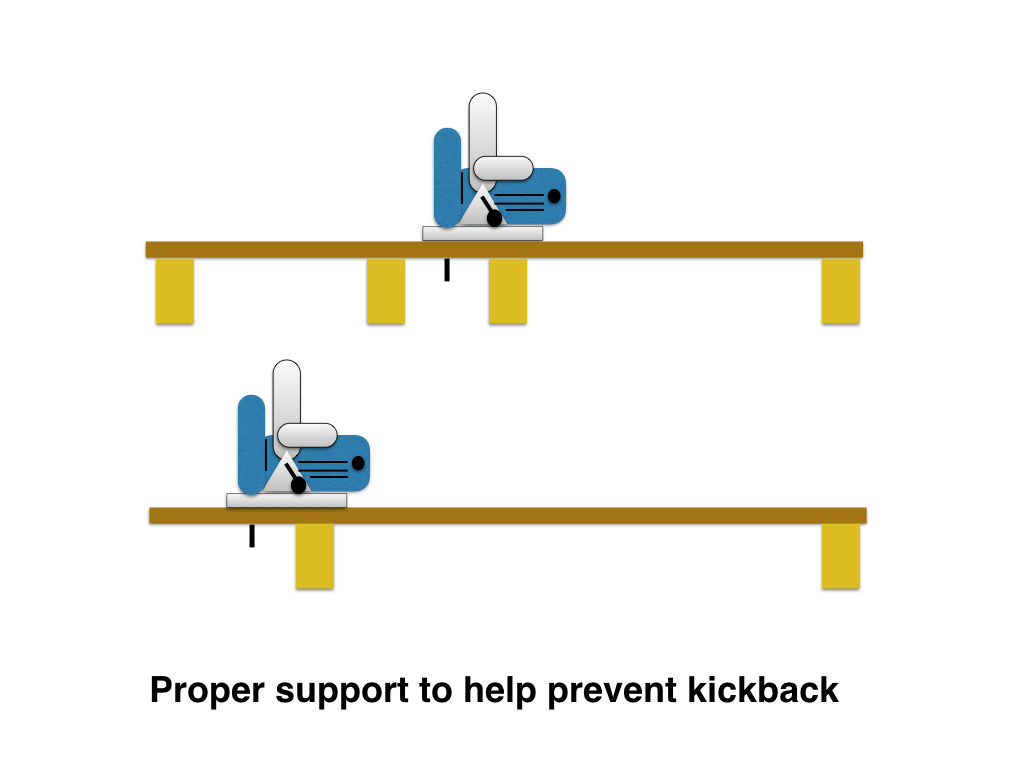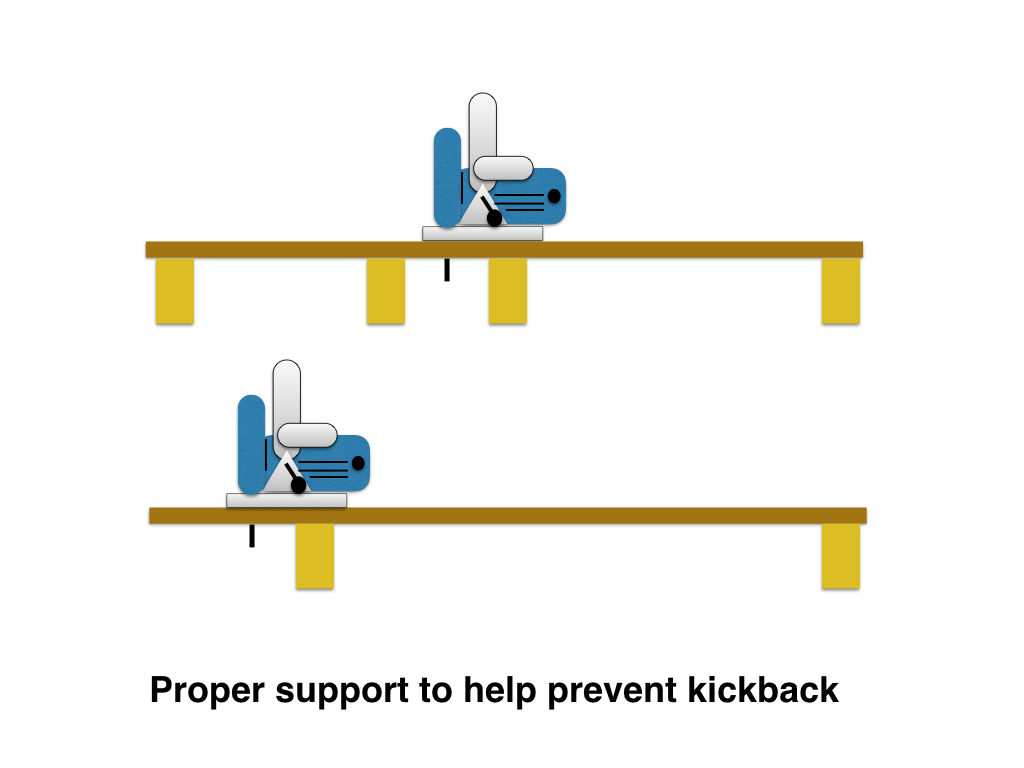Welcome to the world of woodworking, where power tools can be both exciting and a little intimidating. Today, we’re going to dive into the topic of circular saw kickback. But before we get into the nitty-gritty, let’s address our first question: “What is circular saw kickback?”
Picture this: you’re using a circular saw to make a precise cut through a piece of wood, and suddenly, the saw jerks back with a jolt. That’s circular saw kickback! It’s like the saw throwing a little tantrum, and trust me, you definitely don’t want to be on the receiving end of it.
Circular saw kickback can be dangerous and even cause serious injuries if you’re not careful. But fear not! In this article, we’ll walk you through everything you need to know about circular saw kickback, how to prevent it, and what to do if it happens. So, let’s get started and make sure you’re equipped with all the knowledge to stay safe and confident while using a circular saw. Let’s do this!

What is Circular Saw Kickback? Understanding the Dangerous Phenomenon
Kickback is a common term used in woodworking, specifically when it comes to using a circular saw. It refers to the sudden and violent movement of the saw blade towards the user, often resulting in serious injuries and accidents. Circular saw kickback can occur due to various factors, including improper tool usage, lack of safety precautions, and certain limitations of the saw itself. In this article, we will explore what circular saw kickback is, its causes, and how to prevent it for a safer woodworking experience.
The Physics behind Circular Saw Kickback
To understand circular saw kickback, it is important to grasp the physics behind the phenomenon. When a circular saw is in use, the blade rotates at high speeds, cutting through the material being worked on. However, if the blade encounters an obstacle or encounters excessive resistance in the material, it can lead to a sudden change in motion. This change in motion generates a reactionary force that pushes the saw in the direction opposite to the initial cutting motion, causing the dangerous kickback.
Several factors contribute to the occurrence of circular saw kickback. Firstly, if the blade gets pinched or bound in the material being cut, it can cause the saw to twist or jerk back towards the user. Secondly, if the blade encounters a knot or a harder area within the material, it can lead to the blade getting deflected, resulting in kickback. Lastly, improper handling or imbalance of the saw, such as using excessive force or not holding the saw securely, can also contribute to kickback incidents.
Preventing Circular Saw Kickback: Tips and Best Practices
While circular saw kickback can be a dangerous and unpredictable occurrence, there are several precautions and best practices that woodworkers can implement to minimize the risk. Here are some important tips to prevent circular saw kickback:
1. Use a circular saw with a riving knife: A riving knife is a safety feature attached to the saw blade that helps prevent kickback by keeping the kerf separate and preventing the material from pinching the blade.
2. Maintain a proper cutting line: Always ensure that you are cutting along the designated line and not deviating. Taking your time and using guide rails or clamps can help maintain a straight and accurate cutting path, reducing the chances of kickback.
3. Choose the right blade and blade depth: Using the right type of blade for the specific material you are cutting is crucial. Additionally, adjusting the blade depth to the appropriate level will ensure that the blade is not exposed too much, reducing the risk of kickback.
4. Support the material properly: When cutting larger pieces of material, it is important to provide adequate support to prevent any movement or tilting. This can be done using sawhorses, workbenches, or additional support structures.
5. Wear appropriate protective gear: Always wear safety goggles, hearing protection, and gloves when operating a circular saw. These safety measures can help protect you in the event of a kickback incident.
By following these safety guidelines and being mindful of the potential dangers of circular saw kickback, you can significantly reduce the risk of accidents and ensure a safer woodworking experience. Remember, proper training, awareness, and precautionary measures are paramount in preventing kickback and maintaining a safe working environment.
Key Takeaways: What is Circular Saw Kickback?
- Kickback is a dangerous event that happens when a circular saw blade suddenly jerks back towards the user.
- It can occur when the saw gets pinch or binds in the material being cut.
- To prevent kickback, always use a sharp blade and avoid forcing the saw through the material.
- Position yourself to the side of the saw blade, not in line with it, to reduce the risk of injury during kickback.
- Wearing appropriate safety gear, such as safety glasses and gloves, is essential when using a circular saw.
Frequently Asked Questions
Welcome to our FAQ section on circular saw kickback. In this guide, we will address some common questions you may have about this safety concern in woodworking and how to prevent it. Read on to find answers that will help you stay safe and efficient while using a circular saw.
1. How does circular saw kickback happen?
Circular saw kickback occurs when the wood being cut gets thrown back toward the operator with force. It can happen due to a variety of reasons, such as misalignment of the blade, improper technique, or cutting knots or other irregularities in the wood. When kickback happens, it can be dangerous and cause injuries.
To prevent kickback, always ensure the blade is aligned properly, use the correct blade for the job, and keep the saw blade sharp. Additionally, take proper safety precautions, such as using protective eyewear and gloves, and stand to the side of the saw blade while cutting.
2. What are the dangers associated with circular saw kickback?
Circular saw kickback can be extremely dangerous and cause serious injuries. The wood being thrown back can hit the operator or bystanders with significant force, resulting in cuts, bruises, or worse. It can also lead to the operator losing control of the saw, posing a risk of further accidents or damage to property.
By understanding the potential dangers and taking necessary precautions, such as using a riving knife or anti-kickback pawls, maintaining a firm grip on the saw, and keeping a stable stance, you can greatly minimize the risks associated with circular saw kickback.
3. Are there any specific techniques to prevent circular saw kickback?
Yes, there are several techniques that can help prevent circular saw kickback. First, always use a push stick or a push block to keep your hands away from the blade. This ensures a safe distance between the operator and the wood being cut. Second, maintain a steady and controlled feed rate, avoiding sudden or jerky movements that can increase the chances of kickback.
Additionally, be mindful of the positioning of your hands and body. Use a two-handed grip on the saw, with one hand on the main handle and the other on the auxiliary handle. Keep your body positioned to the side of the blade, rather than directly behind it. These techniques, in combination with proper blade alignment and regular maintenance of the saw, can significantly reduce the risk of kickback.
4. Can the use of safety features on a circular saw help prevent kickback?
Absolutely! Many modern circular saws come equipped with safety features designed to prevent kickback. These features include riving knives and anti-kickback pawls. A riving knife is a metal projection that sits behind the blade and helps to prevent the wood from pinching the blade, reducing the likelihood of kickback. Anti-kickback pawls are small teeth that grab onto the wood and prevent it from getting thrown back towards the operator.
It is important to ensure that these safety features are in good working condition and properly adjusted before using the saw. Regularly inspect and maintain your circular saw to make sure all safety features are functional and provide the highest level of protection against kickback.
5. Are there any specific guidelines for kickback prevention when cutting different types of wood?
While the basic principles of kickback prevention remain the same, it is important to take certain factors into consideration when cutting different types of wood. For example, when cutting hardwood or wood with knots, kickback is more likely to occur. Take extra care in these situations by adjusting the feed rate accordingly and ensuring a smooth and controlled cut.
When working with larger pieces of wood, make sure you have the necessary support and stability to prevent the wood from tipping or binding, which can lead to kickback. Understanding the characteristics of the wood you are cutting and adapting your technique accordingly will go a long way in preventing kickback and ensuring safe and efficient woodworking.

Makita Circular Saw – How to Reduce Circular Saw Kickback
Summary
Circular saw kickback happens when the saw blade gets stuck or bound in the wood, causing it to suddenly jerk back towards the user. This can be dangerous and can result in serious injuries. To prevent kickback, it’s important to use the right blade, keep the blade sharp, and use the saw properly by following safety guidelines. Stay safe and happy woodworking!
